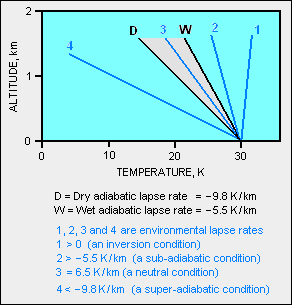User:Milton Beychok/Sandbox: Difference between revisions
Jump to navigation
Jump to search
imported>Milton Beychok No edit summary |
imported>Milton Beychok No edit summary |
||
| Line 1: | Line 1: | ||
{{Image|Lapse rates.png|right|292px|Diagram of the various lapse rates defining the change of atmospheric temperature with altitude.}} | {{Image|Lapse rates.png|right|292px|Diagram of the various lapse rates defining the change of atmospheric temperature with altitude.}} | ||
The | The '''lapse rate''' (symbol <math>\Gamma</math>) refers to the change of an atmospheric variable with a change of altitude, the variable being [[temperature]] unless another variable is specified (such as [[pressure]], [[Density (chemistry)|density]], [[humidity]] or [[wind speed]]).<ref>The atmospheric lapse rate is very often defined as the negative change of temperature with a change of altitude. That leads to statements such as "A positive lapse rate indicates temperatures cooling as height increases while a negative lapse rate indicates warming as height increases" which is counter-intuitive since lapse rates are usually expressed as a negative number (i.e., - 6.5 K/km)</ref> While usually applied to Earth's atmosphere, the concept of lapse rates can be extended to atmospheres (if any) that exist on other planets. | ||
== References == | == References == | ||
{{reflist}} | {{reflist}} | ||
== Hold items == | |||
<ref>{{cite book|author=Mark Zachary Jacobson|title=Fundamentals of Atmospheric Modeling|publisher=Cambridge University Press|edition=2nd|year=2005|isbn=0-521-83970-X}}</ref><br/> | |||
<ref>{{cite book|author=C. Donald Ahrens|title=Meteorology Today|publisher=Brooks/Cole Publishing|edition=8th|year=2006|isbn=0-495-01162-2}}</ref> | |||
Revision as of 18:41, 21 August 2009
The lapse rate (symbol ) refers to the change of an atmospheric variable with a change of altitude, the variable being temperature unless another variable is specified (such as pressure, density, humidity or wind speed).[1] While usually applied to Earth's atmosphere, the concept of lapse rates can be extended to atmospheres (if any) that exist on other planets.
References
- ↑ The atmospheric lapse rate is very often defined as the negative change of temperature with a change of altitude. That leads to statements such as "A positive lapse rate indicates temperatures cooling as height increases while a negative lapse rate indicates warming as height increases" which is counter-intuitive since lapse rates are usually expressed as a negative number (i.e., - 6.5 K/km)
Hold items
- ↑ Mark Zachary Jacobson (2005). Fundamentals of Atmospheric Modeling, 2nd. Cambridge University Press. ISBN 0-521-83970-X.
- ↑ C. Donald Ahrens (2006). Meteorology Today, 8th. Brooks/Cole Publishing. ISBN 0-495-01162-2.

